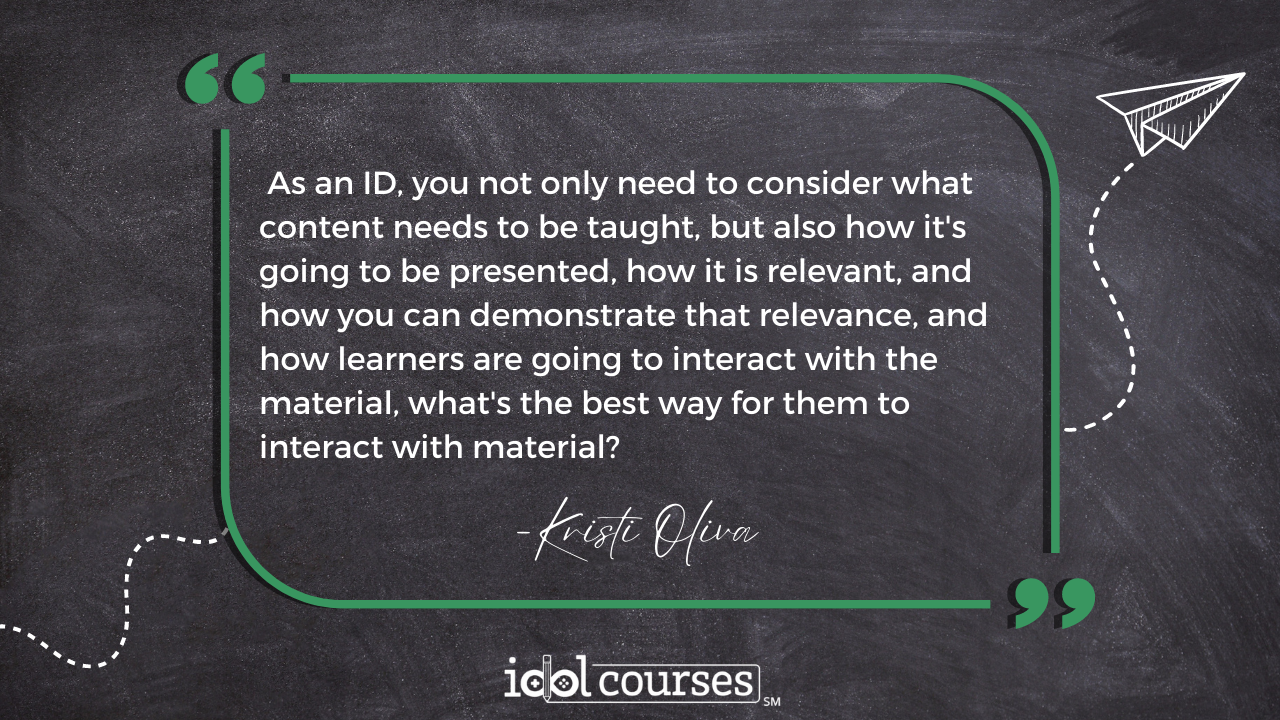Leaving the Classroom Episode 11: 5 Instructional Design Acronyms
May 16, 2023
Leaving the Classroom: A Transitioning Teacher Podcast
5 Instructional Design Acronyms You Need to Know
There is a whole new language to learn in the instructional design world. In this episode, learn 5 of the terms you need to know for instructional design, and they all happen to be acronyms.
Listen to the episode here:
Connect with Kristi on LinkedIn
Enjoy the podcast transcription:
Hello, everyone. Welcome to leaving the classroom. I'm Kristi Oliva. And I'm so glad you are here. Today I'm talking about the terminology, specifically acronyms you need to know to leave the classroom and pursue a career in instructional design. Now acronyms when you enter the corporate world, and you know this happens, even in teaching, that is just acronym city, there are so many acronyms you need to get to know in order to feel comfortable. And to be honest, there's always new ones, always new ones being added. But there are some staples that you need to know, to understand instructional design. And so we're gonna talk about five of those today. Not only is there a whole new language to learn for the instructional design world, but there is corporate specific jargon to learn as well.
But today, I'm gonna focus on five of the acronym terms you need to know for instructional design. The first one is ID, which is instructional design. And this is the process of designing, developing and delivering learning experiences. When you're an instructional designer, that's what you're doing. And a successful instructional designer will have a deep understanding of how people learn best. And they're able to create learning experiences, most of the time courses or job aids that are tailored to the individual needs of learners, as best they can. And you know how to do that as a teacher. That's what you do. Instructional Design is a holistic approach, though, to creating effective teaching and learning materials.

The second one is Smee, SME. And this stands for subject matter expert. Now, as a teacher, you have been expected to be the subject matter expert. If you're a history teacher, you're not going to somebody else, and then teaching what they're telling them about history, you went to school and learned about history. And now you're teaching that history. So you're the teacher, the counselor, the curriculum manager, you're all of the above, and I'm sure I'm missing other roles that you play. But when you become an instructional designer, you are no longer expected in most cases, to be an expert in the topics, you are building the learning around. And that's where this Smee comes in SME, they provide the knowledge and expertise on whatever it is you're teaching to your learners. For example, when I worked as a contractor for Google, I was building courses for their data center employees. And a lot of these were engineers, really, really smart people. And I had no clue what I mean, I did not know these subjects, I did not know about the voltage of the electricity but this is what I was expecting to build courses on. So I had to consult with those Smees those subject matter experts on a weekly basis. And they were giving me the content, they were giving me the knowledge but I wasn't even expected to learn it. I was just building the coursework, and how deciding how to best present that material to new people to that goal. Okay, that's what this Smee does.
Okay, the next term is an industry standard, and it is Addie, A D D I E. And ADDIE is a framework for instructional design that stands for analysis, design, development, implementation, and evaluation. So it's the process of instructional design. It's used to plan, create, and evaluate effective learning experiences. Addie is important because it outlines the process you follow every time you need to create a new learning experience. It will help you plan and manage every step of the design process to ensure you create the best possible learning experience. And there are some iterations to this at specifically at my team on Amazon, we have an iteration of this called PADDIE M. So we added a a p to the beginning and an M to the end. And so that can happen as well or there's the agile approach or there's the SAM model. They're all iterations of this that basically outline the process you're going to go through. But in my opinion, it all comes back to Addie, you do need to do the analysis, design, development, implementation and evaluation of your coursework. So whether or not you're doing that in that strict order and not revisiting the steps, that's the difference. But to me, it all comes back to Addie. So it's important to know that and be able to speak on it. So that's one of the acronyms you need to know.
The fourth one is LMS. LMS stands for learning management system. Learning Management Systems are software platforms. And they provide the tools needed to create, distribute, and manage digital learning materials. So it's kind of like the online classroom, for the instructors and the learners. It's where you house your courses, and everything that you want to be able to track for your learners. So with the LMS, instructors, the instructional designers, whoever can create courses, they can upload the course content to the LMS. They can host live sessions through the LMS. The assessments can be in the LMS. And you can track performance data, and that's one of the most important pieces for the learning management system is being able to track that performance data. Did the learners complete the course? How well did they do you can even track things like what they clicked on, and how often and where they got stuck. So the goal of an LMS is to improve the effectiveness and efficiency of learning by providing learners with an engaging and interactive learning experience. But it also gives the instructional designers, the administrators, the learning team, visibility into student progress so that you can target support when it's needed and where it's needed.
All right, the last acronym that we're going through today, there are many, many more is ILT. And ILT stands for instructor led training. ILT is a type of instructional design that involves a traditional face to face classroom setting. Now face to face could mean virtual as well. And those are called VILTs, but either way, it's that live in person, synchronous setting. Most grade school classes are ILT. So you're familiar with this as a teacher, that's what you do is you basically are building and facilitating ILTs. The instructor or the facilitator leads the group of learners through the course material by delivering lectures, for instance, or leading activities, discussions, it could be a flipped classroom model where they go through a course, on asynchronous course first, and then you're having discussion in the ILT. There's so many ways to approach this. But the ILT gives the opportunity for students to get maybe individual attention, ask live questions and get that support, right there and then.
Okay, so these are the five acronyms that you need to know in order to enter the instructional design space. And you will learn all of this and more in IDOL courses Academy and so if you are ready to join IDOL courses Academy and leave the classroom, I'm inviting you to check it out, sign up using my code CLASSROOM100 and get $100 off enrollment. It's time to take control and make the career change that will change your life. It changed mine. See you next time. That's all for this episode. But you can find more at idolcourses.com or subscribe to the podcast. And if you are ready to leave the classroom, use my code CLASSROOM100 and get $100 off enrollment to IDOL courses Academy.
Send your stories or your questions to [email protected] or share them with me on Instagram @leavingtheclassroom.
Stay connected with news and updates!
Join our mailing list to receive the latest news and updates from our team.
Don't worry, your information will not be shared.
We hate SPAM. We will never sell your information, for any reason.


